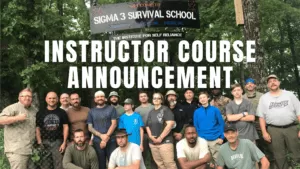Can you stay alive outdoors by assessing risks? The summer outdoor season sees an increase in reports about disappearances and accidents. A recent report from California discusses the disappearance of an experienced hiker at a campsite in the Bristlecone Pine Forest. She was later found alive after four days. The report reveals that she had to flee her location due to a threatening person. Another story relates the discovery of the body of a missing person on the Snake River in Wyoming. He was working at a KOA campsite. Outdoor activities can be great experiences. However, outdoor activities also have inherent risks. You should develop a risk assessment and reduction plan before you go on a wilderness adventure. The following principles can help you build your risk mitigation plan.
1. Assess the level of wilderness experience and field skills of yourself and others
It is terrific to have a desire to spend time outdoors. There is an increasing number of people heading to the wilderness to hunt, hike, camp, or fish. The growing popularity of survival-related reality television programs and the rising interest in survival and preparedness are motivating people to get outdoors. However, the reality of being in the wilderness is different from how it is portrayed in the mass media. There is a danger of overconfidence in one’s abilities.
It is prudent to be realistic in assessing the level of wilderness experience and field skills of yourself and those in your group. The less wilderness experience and skills that one has should be an indicator that they are a high risk to themselves and others. Therefore, it is imperative to take a partner with you into the outdoors. Your partner should be more experienced and have more field skills than you to compliment your weaknesses. As a matter of safety, you should never go into the wilderness by yourself regardless of how skilled and experienced you are with the outdoors.
2. Know the level of health and physical fitness of yourself and others.
It is vital to know your level of health and physical fitness. Health and physical fitness play an important role in determining the kinds of activity and locations that one visits. For example, people with high blood pressure might have limitations as to the types of trails that they can trek on a backpacking adventure.
3. Understand the natural or man-made dangers of the area of activity
One of the common characteristics of negative experiences in the outdoors is a lack of awareness of the risks. More specifically, there seems to be a lack of knowledge of the natural and man-made dangers in the area of activity. One type of natural hazard involves predatory animals, such as mountain lions or bears. Other inherent threats are those relating to the terrain such as cliffs, bodies of water, areas of deadfall, or unstable ground. Man-made dangers are those pertaining to human activity. These can comprise logging areas, areas of construction, or even previous criminal activity.
4. Analyze the local weather and weather anomalies of the area of activity
Weather is a contributor to outdoor risks. There are reports of sudden fog, rain, or dropping of temperatures even in the summer months in some locations. It must be remembered that some local weather patterns cannot be found in a national or local forecast. The people who live near the area of your outdoor activity can provide useful information on local weather activity such as afternoon thundershowers. Analyzing the local weather traits will help make decisions about what to put in your backpack, such as rain gear or a light fleece jacket.
5. Identify the level of access to emergency help in the area of activity
Sometimes people, who go outdoors, do not take into account the availability of emergency help. It is essential to have a good understanding of what kind of emergency help is available. Additionally, it is crucial to know how to access emergency help in your planned area of activity. The importance of knowing how to contact emergency help is a critical part of your outdoor planning.
For example, one of the areas near me does not have a large number of park rangers. They tell you when you come into the park that most emergency help will be by airlift. They do not have the personnel or transportation available to come to your aid if you call for help. Thus, an expensive life flight to a local hospital awaits, should you dial for help. That kind of information influences your activity and what you have in your gear. Some wilderness areas have no cell phone access. How will you get help in an emergency?
It is recommended that you develop a first-responder contact card. This card should have contact information for park rangers, first responders, and area hospitals. You should include emergency radio channels on the card if you are carrying a handheld ham radio two-way transceiver with you.
Final Thoughts
Risk reduction is an important skill to develop and exercise for those who love the outdoors. Your risk reduction plan has its limitations. However, without one, you may find your activity being less than enjoyable. Once you have identified the risks for your planned wilderness adventure, then develop and implement measures to reduce that risk. One of the best techniques to consider for risk reduction measures is the PACE plan. Additionally, your risk reduction plan should take into account the kind of activity (Mission), local and area dangers (Enemy), time of day, month or day (Time), the people involved (Troops), location (Terrain), and accesses to emergency help (Civilian Considerations). Once you have your risk mitigation plan complete, give a copy to whomever, you will be making your communication checks while you are outdoors.
This post may contain affiliate links which means I may receive a commission from purchases made through the links. I only recommend products I personally use and love, so if you support what we are doing, thanks for clicking.










